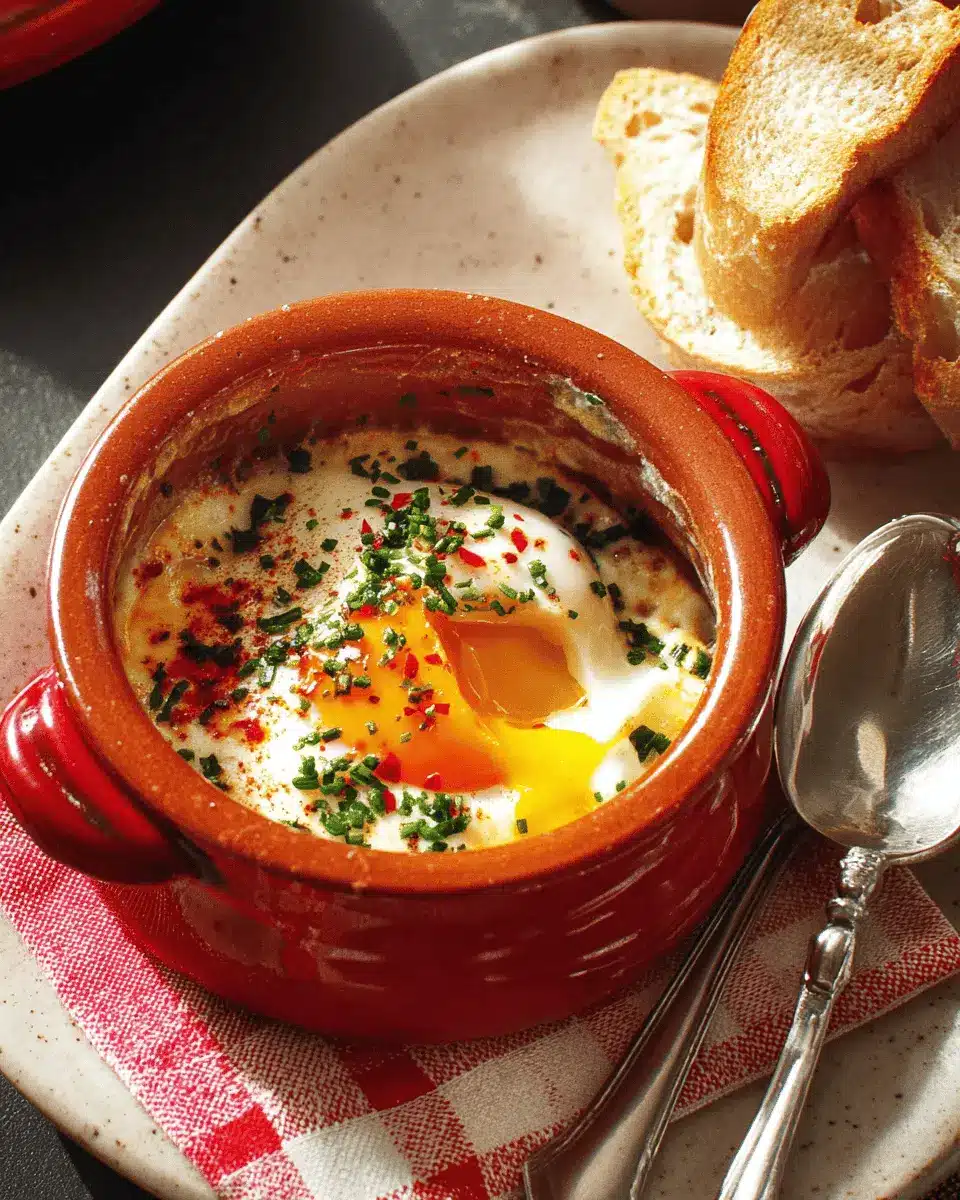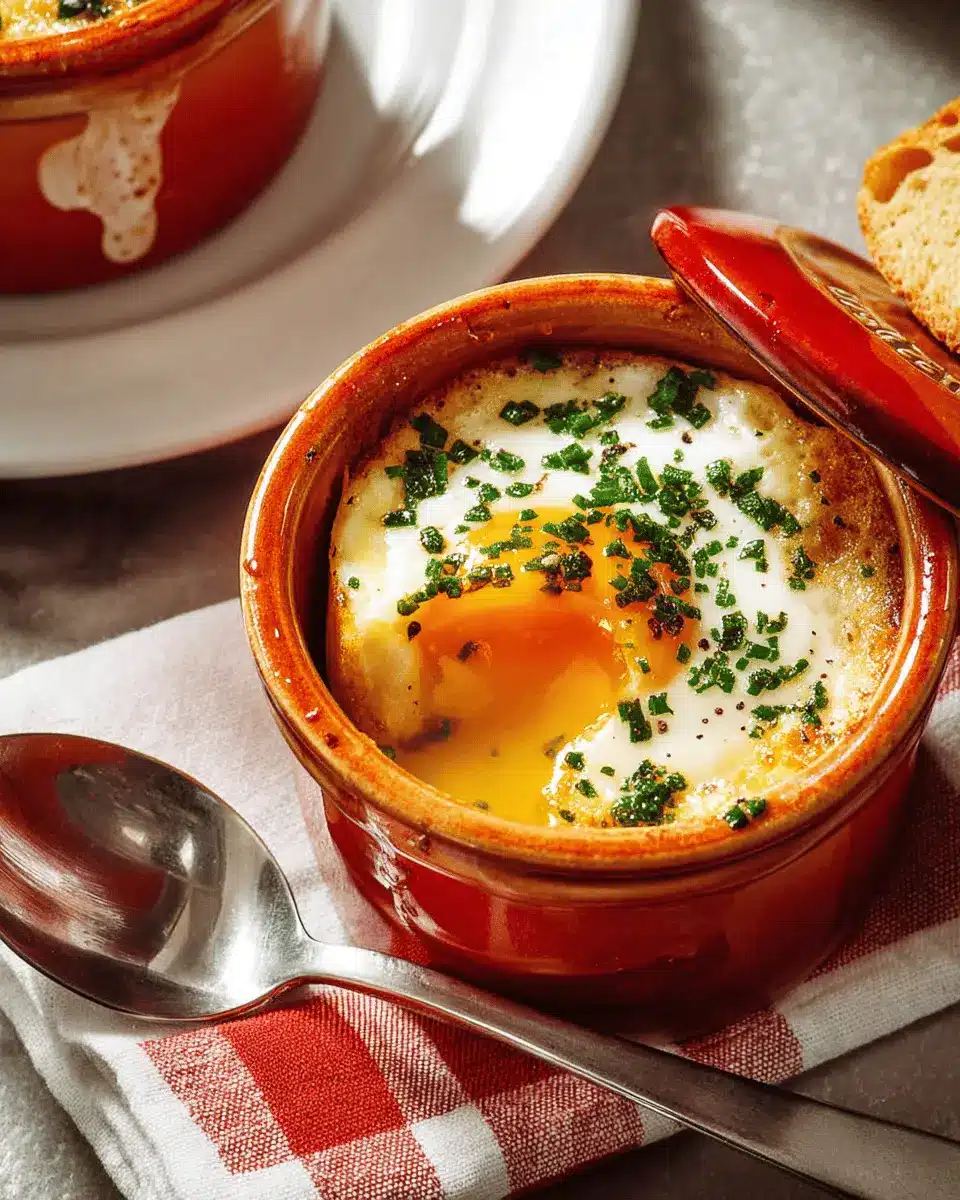Introduction to Eggs en Cocotte
Eggs en cocotte, also known as “baked eggs,” is a cozy and elegant dish that any young professional can whip up with ease. This delightful meal not only satisfies your hunger but also impresses anyone you might be dining with. When you’re juggling a busy schedule, finding a recipe that’s both quick and impressive is essential.
Why Eggs en Cocotte is the Perfect Meal for Young Professionals
Eggs en cocotte is the ideal brunch option or light dinner that can be customized to your taste. Imagine coming home after a long day and treating yourself to a warm, comforting egg dish—sounds fabulous, right? This recipe takes less than 15 minutes of prep time, allowing you to indulge without the hassle.
Plus, the versatility of eggs en cocotte means you can easily swap ingredients based on what you have on hand. Want to add some turkey bacon or chicken ham? Go for it! The addition of herbs and spices can elevate the dish to gourmet status, making it suitable for both casual nights in or surprise guests.
If you’re interested in food creativity, this dish can be a great platform for experimenting with flavors. Just think about it—delicate eggs baked to perfection, paired wonderfully with warm, buttered toast. It’s comfort food at its finest, and it’s just waiting for you to give it a try. Looking for cooking tips and more delightful recipes? Check out Food Network for inspiration!

Ingredients for Eggs en Cocotte
Essential ingredients for a creamy delight
To whip up a delightful batch of eggs en cocotte, you’ll need a few essential ingredients. Start with unsalted butter to generously grease your ramekins—this adds a rich flavor and ensures your eggs slide out effortlessly. Don’t forget kosher salt and freshly ground pepper to enhance the taste.
You’ll need 4 large eggs to create that creamy center, topped with 4 tablespoons of finely chopped chives for a fresh bite. For an extra layer of indulgence, consider adding 4 tablespoons of heavy cream—this optional ingredient transforms the texture into a luxurious experience. And serve it all with some warm buttered toast for the perfect breakfast pairing!
Alternative ingredients for dietary preferences
If you’re looking for alternatives for your eggs en cocotte, consider these substitutions:
- Dairy-free options: Use plant-based butter and a dairy-free cream substitute.
- Veggies: Feel free to mix in sautéed spinach, mushrooms, or tomatoes for added flavor and nutrition.
- Meat alternatives: Swap in Turkey Bacon or Chicken Ham to cater to your taste preferences.
Cooking should always cater to your needs! For more ideas on ingredient swaps, check out informative resources like the USDA.
Preparing Eggs en Cocotte
Are you ready to dive into the delightful world of eggs en cocotte? This dish brings sophistication to your table without the fuss. Let’s break down the steps to ensure that your eggs come out perfectly creamy and flavorful every time. It’s an easy but high-impact dish that’s perfect for brunch or a quick weeknight dinner.
Set up your cooking environment
Before we get started, it’s essential to create a comfortable cooking space. You’ll need a large skillet, preferably a non-stick one to ensure easy cleanup later. Fill it with water so that it reaches about half an inch up the sides — this creates a gentle cooking environment for your eggs. Bring the water to a simmer over medium heat; it’s crucial not to let it boil too fiercely, as a gentle simmer will cook the eggs evenly. Next, gather your ramekins. Four 8-ounce ramekins are ideal for this recipe.
Grease and prepare the ramekins
A well-greased ramekin is key for ensuring your eggs en cocotte slide out effortlessly post-cooking. Take your room-temperature unsalted butter and generously coat the insides of each ramekin—about a teaspoon each will do. Then, sprinkle a pinch of kosher salt and some freshly ground pepper into each ramekin for that added flavor boost. Now, divide the 4 tablespoons of finely chopped chives among the ramekins, ensuring an even distribution. Not only does this enhance flavor, but it also looks beautiful!
Crack the eggs and add the chives
This is where the magic happens. Carefully crack one large egg into each greased ramekin, and don’t worry if a bit of shell gets in there—just fish it out! Feel free to get creative here. You can add toppings such as turkey bacon for a protein punch or even some chicken ham for extra flavor. Once you've added your ingredients, it’s time to prepare for cooking.
Cook your eggs to perfection
Gently transfer your ramekins into the skillet filled with simmering water. Cover the skillet with a lid and keep a watchful eye on those eggs. Adjust the heat to ensure a steady simmer. You’ll want to cook them until the whites are set, but the yolks still maintain that luscious, runny quality. This process will take about 4 to 7 minutes depending on how runny you like your yolks.
Finish with cream and serve
To elevate your eggs en cocotte, drizzle a tablespoon of heavy cream over each egg after they are cooked. Season with a touch more salt and pepper, and voila—you’re ready to serve! Pair them with some warm buttered toast, and you have a fabulous meal that’s sure to impress.
Enjoy the creamy goodness of your eggs en cocotte, and feel free to explore different toppings and ingredients to make it your own. Happy cooking!
For further inspiration on preparing eggs to perfection, check out The Incredible Egg for tips and tricks!

Variations on Eggs en Cocotte
Incorporating veggies for a healthy twist
Elevate your eggs en cocotte by adding a medley of sautéed or roasted vegetables. Spinach, bell peppers, or sun-dried tomatoes not only boost flavor but also pack in vitamins that enhance your meal's health benefits. A sprinkle of nutritious greens or other colorful veggies can turn your dish into a vibrant feast. For some inspiration, check out seasonal vegetable recipes that pair beautifully with egg dishes on platforms like Eating Well.
Adding proteins like turkey bacon or chicken ham
For a heartier twist, consider incorporating proteins such as turkey bacon or chicken ham into your eggs en cocotte. Simply chop them into bite-sized pieces and sprinkle them atop the eggs before baking. These additions bring a savory richness and an appealing texture that balances the creaminess of the dish. If you're looking to keep it lighter, turkey options are a fantastic substitute for traditional pork products. Enjoy experimenting with these tasty inclusions to find your ideal combination!
Cooking tips and notes for Eggs en Cocotte
How to achieve the perfect runny yolk
To ensure that your eggs en cocotte have the perfect runny yolk, timing is key. Start checking around the 4-minute mark—your goal is for the whites to be set while the yolks remain silky and spreadable. If you're unsure, use a teaspoon to test a yolk gently; it should jiggle slightly but not be liquid. Consistent simmering in the water is important, so adjust the heat as needed.
Best ramekins for uniform cooking
Choosing the right ramekins is essential for even cooking of your eggs en cocotte. Opt for 8-ounce ramekins made from ceramic or oven-safe glass to retain heat effectively. This will help attain that beautifully set white while keeping the yolk deliciously runny. Look for ramekins that allow for adequate circulation of steam but are also snug enough to create a gentle cooking environment. Check out this guide for some great ramekin recommendations!

Serving suggestions for Eggs en Cocotte
Pairing with warm buttered toast
When serving eggs en cocotte, nothing complements their creamy texture better than a slice of warm buttered toast. The crunchiness of the toast creates the perfect contrast to the sumptuous eggs, allowing you to soak up every delicious bite. Choose a hearty bread, like sourdough or whole grain, for added flavor and nutrition. Feel free to sprinkle a pinch of sea salt or smoked paprika on the toast for an extra kick!
Creative sides that complement the dish
Looking to elevate your meal? Consider adding some creative sides that pair wonderfully with eggs en cocotte:
- Turkey bacon: Crispy and savory, it’s a lighter alternative that adds protein without overwhelming the dish.
- Chicken ham: A delightful choice, offering a subtle, smoky flavor that complements the eggs beautifully.
- Roasted tomatoes: Adding a splash of color and sweetness, these bring freshness to your plate.
For a refreshing contrast, serve a side salad dressed with a zesty vinaigrette. These sides not only enhance your meal but also make it feel like a gourmet experience at home! Explore more about these side options on BBC Good Food or Food Network.
Time breakdown for Eggs en Cocotte
Preparation time
Getting ready for your eggs en cocotte experience takes about 10 minutes. This includes gathering ingredients, greasing the ramekins, and getting the skillet set up—all essential steps for a smooth cooking process.
Cooking time
Once you’ve prepped everything, the cooking will take around 4 to 7 minutes. This is the time it takes for those eggs to reach the perfect consistency—just firm whites and magically soft yolks!
Total time
By the time you finish preparing and cooking, you’re looking at a tasty total of about 20 minutes. Just enough time to brew some coffee or pick out your favorite toast to accompany this delightful dish.
Ready to master the finesse of eggs en cocotte? Check out our complete recipe above!
Nutritional facts for Eggs en Cocotte
Calories per serving
A serving of eggs en cocotte typically contains around 300 calories. This makes it a delightful option for a hearty breakfast or a comforting brunch without tipping the scale too heavily.
Protein content
Eggs are a fantastic source of protein, and with each serving of eggs en cocotte, you're getting about 14 grams. This not only helps keep you full but supports muscle health and energy levels throughout your day.
Sodium levels
When embracing those delicious eggs en cocotte, the sodium content can vary based on your seasoning choices. On average, expect around 500 mg of sodium per serving if you use a bit of kosher salt. For a healthier twist, consider adjusting the salt or using low-sodium alternatives to maintain flavor without the excess sodium.
For more insights on the nutritional benefits of eggs, check out resources from Nutrition.gov or The American Heart Association. These sources offer a deeper dive into how eggs can fit into a balanced diet.
Incorporating eggs en cocotte into your meal plan provides not just comfort but also vital nutrients. Enjoy this delightful dish knowing it supports your health and taste buds!
FAQs about Eggs en Cocotte
Can I make eggs en cocotte ahead of time?
Absolutely! You can prepare the ramekins with eggs and toppings and then cover them tightly with plastic wrap. Store them in the refrigerator for up to 24 hours. When you're ready to eat, simply remove them from the fridge and pop them into the simmering skillet. Just be sure to add a minute or two to the cooking time for the chill.
What can I use if I don't have ramekins?
Don’t worry if you’re lacking ramekins — you can easily substitute with any oven-safe small bowls or even coffee mugs. Just ensure they can withstand the heat, and don’t forget to grease them well with butter to prevent sticking!
How do I know when my eggs are cooked just right?
Perfectly cooked eggs en cocotte should have set whites and runny yolks. Keep an eye on them as they cook; about 4 to 7 minutes is ideal. If you’re uncertain, you can gently jiggle the ramekin — a little wiggle in the yolk means it’s just right! Want to learn more about eggs? Check out these expert cooking tips.
Conclusion on Eggs en Cocotte
Creating your own eggs en cocotte is a celebration of homemade meals that blend simplicity with elegance. This dish not only delights the palate but also warms the heart, making it a perfect choice for brunch or a cozy dinner. Embrace the charm of home cooking and savor each nourishing bite.
Emphasizing the Beauty of Homemade Meals
There’s truly something special about whipping up a meal from scratch, especially something as satisfying as eggs en cocotte. The aromatic chives, the rich cream, and the perfectly cooked eggs come together in an exquisite way that store-bought meals just can't replicate. Plus, crafting this dish allows you to tailor it to your preferences—add fresh herbs, choose between Turkey Bacon or Chicken Ham, or mix in your favorite cheeses.
Homemade meals like this not only nourish the body but also enhance your life with the joy of cooking. They offer the chance to slow down, relish the process, and connect with loved ones over a shared table. Ready to make this delightful dish? Grab your ingredients and start cooking! For more inspiration and tips on homemade meals, check out BBC Good Food for a treasure trove of delicious ideas.
By incorporating eggs en cocotte into your repertoire, you'll be feeding both your body and soul. Enjoy every moment of creating something beautiful in your kitchen!

Eggs en Cocotte
Equipment
- large skillet
- ramekins
Ingredients
Butter and Seasoning
- 1 teaspoon unsalted butter for greasing ramekins
- kosher salt to taste
- freshly ground pepper to taste
Eggs and Garnish
- 4 tablespoon finely chopped chives
- 4 large eggs
- 4 tablespoon heavy cream optional
- warm buttered toast for serving
Instructions
Cooking Instructions
- Pour water into a large skillet to come ½" up the sides; bring to a simmer over medium heat. Generously grease four 8-oz. ramekins with unsalted butter; sprinkle generously with kosher salt and freshly ground pepper. Divide finely chopped chives among ramekins.
- Crack 1 large egg into each ramekin, then transfer ramekins to skillet and cover with a lid. Cook eggs, adjusting heat as needed, until whites are set and yolks are still soft, 4–7 minutes. Using tongs, carefully transfer ramekins to plates.
- Divide heavy cream (if using) among ramekins; season lightly with more salt and pepper. Serve eggs with warm buttered toast.





Leave a Reply